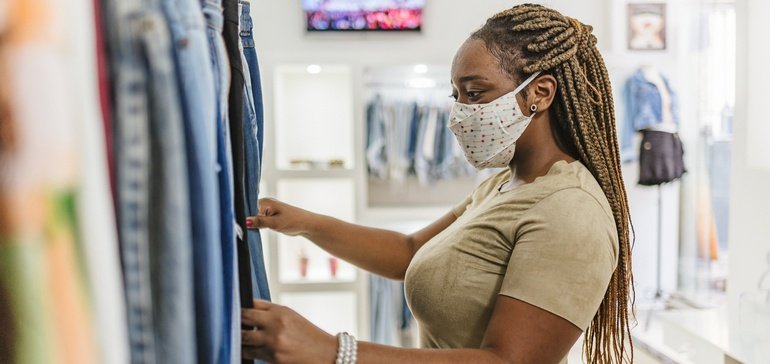Igor Alecsander via Getty Images
AUTHOR|Daphne Howland
Source: www.retaildive.com, December 2020
Dive Brief:
- Apparel retail is set to bounce back, according to a 2021 outlook report from Moody’s Investors Service last week. Operating profit at department stores, including Macy’s, Nordstrom and Kohl’s, will rise over 500%; at off-pricers like TJX Companies and Ross more than 450%; and at apparel and footwear retailers brands like those at Tapestry, Gap Inc. and L Brands by over 100%, Moody’s said.
- The casualization accelerated by the pandemic will continue, as will online sales and healthy living trends, benefiting companies like Nike, Under Armour, V.F. Corp. and Wolverine World Wide, according to the emailed report. Work and formal attire will continue to decline, but companies like PVH Corp. and G-III Apparel Group will prosper thanks to their diversity of merchandise and “ability to tactically evolve product mix.”
- Moody’s expects “strong profit improvement” next year thanks to international sales (where nearly half of U.S. apparel sales as observed by Moody’s are generated) and to sales growth, cost cutting and inventory management. As seen already this season, the latter will lead to “less discounting and more full priced sales,” analysts said.
Dive Insight:
There’s plenty for apparel companies, including much-battered department stores, to cheer about in this report, although their path forward won’t be smooth.
It’s been a rough year, with, as Moody’s points out, steep sales and earnings declines month after month. Overall, the apparel industry’s “profit will plunge 50% to 60% in 2020, then surge 70% to 90% in 2021, primarily in the [second half],” according to the report.
But Moody’s analysts also describe a 2021 ripe for a comeback for some apparel retailers, which this year have had to react not just to the pandemic’s disruption of their front and back operations, but also to swiftly changing consumer behavior. Evidence of their resilience has already emerged, especially in the third quarter.
Many of those behaviors are set to last beyond the pandemic, according to this report, making some of the changes retailers have put in place (including cost cuts and omnichannel services like curbside pickup) valuable longer term as well. That includes the pandemic’s digital acceleration, spurred by the store lockdowns of the spring but unlikely to reverse entirely. Moody’s expects online sales as a percent of total retail sales to exceed 25% over the next five years, and that will have its own effects.
“Migration online will continue to pressure profit margins – but will also increase price transparency, thereby increasing price competition to gain market share,” according to the report.
But the economic uncertainty brought on by the disease outbreak, which is still ongoing, will not abate so quickly, according to Moody’s.
“With the economic recovery still tenuous and unemployment remaining high, we would like to see a more sustained path to normalization in the next couple of quarters before we change our outlook to positive,” the analysts wrote.
The federal government’s failure to renew pandemic-related relief also weighs on discretionary spending, they said. “The consumer has been resilient in the face of unprecedented unemployment, but government stimulus programs have expired, adding uncertainty to the economic rebound.”
The lingering economic troubles will hit financially weaker retailers especially hard and “erode the positive effects of low interest rates on debt servicing capacity,” said Moody’s, noting also that several companies took on more debt to boost their liquidity in recent months. “Since financial leverage has significantly increased, many companies will need to maintain a certain level of sequential improvement in order to maintain ratings.”
Despite the sales recovery, helped along by the upcoming year-over-year comparisons, expect more stores to shut down, Moody’s warned. “US retail has long had too many stores and still has more mall space per capita than any other country in the world,” analysts said. “Where previously these retailers could live with marginally profitable stores, the abrupt mass shift in US shopping habits will cause many more stores with limited economic value to close.”
As apparel retailers adjust their merchandise mix and sales channels to what is shaping up to be an enduring reality, they should also note mounting attention to issues like sustainability and ethics, according to the report.
“Consumers are becoming increasingly mindful of environmental and sustainability issues, the treatment of labor, data protection and responsible product sourcing,” analysts said. “While these factors may not essentially translate into negative credit pressure, over time these factors can affect a company’s brand image.”
Follow Daphne Howland on Twitter


